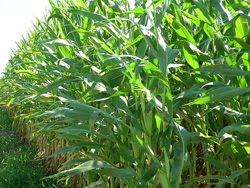Feedstock Sources
The estimated transportation fuel and home heating oil use in the United States is about 230,000 million US gallons annually (Briggs, 2004). Waste vegetable oil and animal fats would not be enough to meet this demand. In America, the estimated production of vegetable oil for all uses is about 23,600 million pounds or 3,000 million US gallons.
Estimated production of animal fat is 11,638 million pounds. (Van Gerpen, 2004)
For a truly renewable source of oil, crops or other similar cultivatable sources would have to be considered, i.e. plants utilizing photosynthesis to convert solar energy into chemical energy, etc. It is this chemical energy that biodiesel stores and is released when it is combusted in an engine. Thus, plants can offer a sustainable oil source for biodiesel production. Different plants produce usable oil at different rates. Some studies have shown the following annual production:
Soybean |
40 to 50 US gal per acre | 55 to 72 Liter per km² |
Rapeseed |
110 to 145 US gal per acre | 160 to 210 Liter per km² |
Mustard |
140 US gal per acre | 200 Liter per km² |
Jatropha |
175 US gal per acre | 250 Liter per km² |
Palm oil |
650 US gal per acre | 950 Liter per km² |
Algae |
10,000 to 20,000 US gal per acre | 15,000 to 30,000 Lit per km² |

Ongoing research is being conducted to finding crops that are more suitable and improving oil yield.
Under current yields, vast amounts of land and fresh water, fertilizer, machinery and labor would be needed to produce enough oil to completely replace fossil fuel usage. In addition, it could put out-of-work farmers back to tilling agro-stock.
 There is not enough arable land in the US to supply a full-blown biodiesel industry.
There is not enough arable land in the US to supply a full-blown biodiesel industry.